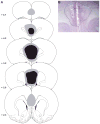Medial prefrontal cortex lesions impair decision-making on a rodent gambling task: reversal by D1 receptor antagonist administration
- PMID: 23354057
- PMCID: PMC3633084
- DOI: 10.1016/j.bbr.2013.01.018
Medial prefrontal cortex lesions impair decision-making on a rodent gambling task: reversal by D1 receptor antagonist administration
Abstract
Decision-making is a complex cognitive process that is impaired in a number of psychiatric disorders. In the laboratory, decision-making is frequently assessed using "gambling" tasks that are designed to simulate real-life decisions in terms of uncertainty, reward and punishment. Here, we investigate whether lesions of the medial prefrontal cortex (PFC) cause impairments in decision-making using a rodent gambling task (rGT). In this task, rats have to decide between 1 of 4 possible options: 2 options are considered "advantageous" and lead to greater net rewards (food pellets) than the other 2 "disadvantageous" options. Once rats attained stable levels of performance on the rGT they underwent sham or excitoxic lesions of the medial PFC and were allowed to recover for 1 week. Following recovery, rats were retrained for 5 days and then the effects of a dopamine D1-like receptor antagonist (SCH23390) or a D2-like receptor antagonist (haloperidol) on performance were assessed. Lesioned rats exhibited impaired decision-making: they made fewer advantageous choices and chose the most optimal choice less frequently than did sham-operated rats. Administration of SCH23390 (0.03 mg/kg), but not haloperidol (0.015-0.03 mg/kg) attenuated the lesion-induced decision-making deficit. These results indicate that the medial PFC is important for decision-making and that excessive signaling at D1 receptors may contribute to decision-making impairments.
Copyright © 2013 Elsevier B.V. All rights reserved.
Figures




References
-
- Floresco SB, St Onge JR, Ghods-Sharifi S, Winstanley CA. Cortico-limbic-striatal circuits subserving different forms of cost-benefit decision making. Cognitive, Affective and Behavioral Neuroscience. 2008;8:375–389. - PubMed
-
- Sonuga-Barke EJ, Fairchild G. Neuroeconomics of attention-deficit/hyperactivity disorder: differential influences of medial, dorsal, and ventral prefrontal brain networks on suboptimal decision making? Biol Psychiatry. 2012;72:126–133. - PubMed
-
- Rogers RD, Robbins TW. Investigating the neurocognitive deficits associated with chronic drug misuse. Curr Opin Neurobiol. 2001;11:250–257. - PubMed
-
- Gallagher DA, O’Sullivan SS, Evans AH, Lees AJ, Schrag A. Pathological gambling in Parkinson’s Disease: risk factors and differences from dopamine dysregulation. An analysis of published case series. Movement Disorders. 2007;22:1757–1763. - PubMed
Publication types
MeSH terms
Substances
Grants and funding
LinkOut - more resources
Full Text Sources
Other Literature Sources
Medical
Miscellaneous

